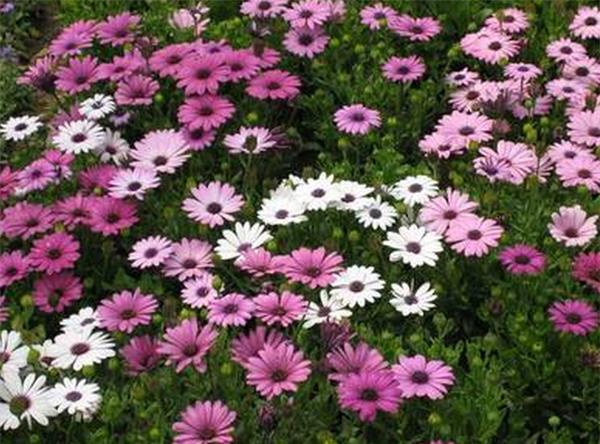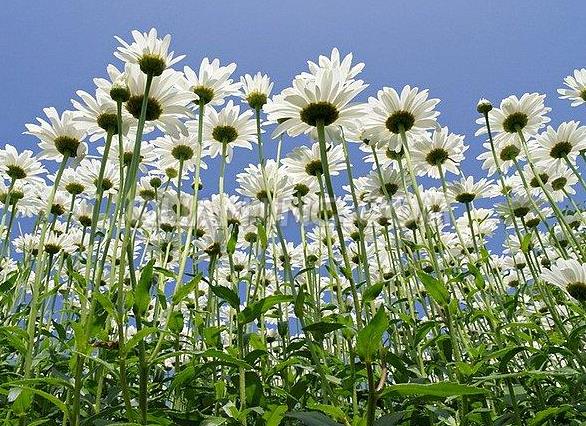Introduction and breeding skills of Binju, a close friend of feminists
Binju is a beautiful ornamental plant. It has beautiful flowers and elegant colors. It shows softness in fortitude. Binju symbolizes feminism. Now, let's have a look together.

I. introduction of Binju
Binju, also known as French chrysanthemum, French chrysanthemum or cow-eye chrysanthemum, is a flowering plant that began in the temperate zones of Europe and Asia and can be used for cultivation and ornamental in parks. Binju, belonging to Compositae, Chrysanthemum, can reach 70 cm in height, alternate leaves, lanceolate, dentate margin, capitate flower on stem tip with a diameter of 9mi 11 cm, disk ligulate flower white, tubular flower yellow, long flowering period, blooming continuously from May to August. Binju is a perennial herb, 15-80 cm high. The stem is erect, with small heads (not more than 5 m) at the top of the stem, consisting of about 20 white ligulate flowers and a large number of yellow heart flowers. The stem is mostly unbranched and grows laterally from the root. The leaves are dark green on both sides. Basal leaves and middle leaves stipitate, Obovate to spatulate, and serrate. The upper leaves are short, sessile and grow along the stem. It has a large number of flat seeds without crown hairs. Basal leaves surviving at anthesis, long elliptic, oblanceolate, Obovate or ovate, 3 mi 8 m long and 1.5 mi 2.5 m wide, base cuneate, attenuate stalk, stalk longer than leaf blade itself, margin rounded or obtusely serrate. The middle and lower stems and leaves are long-elliptic or linear-long-elliptic, narrowed to the base, auriculate or subauriculate to expand the semi-clasping stem, sometimes pinnately lobed below or near the middle. Upper leaves gradually smaller, sometimes pinnatisect. All leaves are glabrous on both sides and the glandular dots are not obvious. Capitate inflorescences solitary stem apical, long pedicellate, or cauline 2-Mel 5-headed inflorescences, arranged loosely corymbose. Involucral bracts 10-20 mm in diameter. All bracts glabrous, margin white or brown hirsute. The tongue is 10-25 mm long. Achenes 2 Mel 3 mm long, without crown hairs or tongue: bark achenes have lateral crown teeth up to 0.4 mm long. Flowering and fruiting period from May to October.

Second, the flower language of Binju
Fancy words: sincerity, fraternity, friendship.
The coastal chrysanthemum blossoms in May and June, with heads, yellow tubular flowers, white ligulate flowers, slender and erect pedicels, and long flower arrangement. Binju's "Bin" and the guest's "guest" are homonyms, guests and friends. It means that the friendship between friends is as pure and honest as the chrysanthemum.
Fancy language: feminism
This is the flower chosen to be dedicated to Saint Tekula, the first female saint in the history of the church, so Binju's flower language is "feminism". Those who are blessed by this kind of flower, as its flower language says, have a strong sense of independence. I think everything can be done on my own. However, if you look closely at the people around you, there must be friends of the opposite sex who can respect your idea, so as long as you can properly manage your friendship, it will develop into love.
September 23rd birthday flowers
The first female saint, the flower of Saint Tecula of Iknelm.
Since ancient times, Christianity has had the habit of connecting saints with specific flowers, because the church often decorates the altar with blooming flowers when commemorating saints. In the medieval Catholic monastery, it was like a horticultural center to grow all kinds of flowers. Over time, the church combines 366-day saints with different flowers to form a so-called calendar. At that time, most of the monasteries were located in southern Europe, which had a mid-sea climate and was very suitable for planting flowers and plants. Binju is Saint Tekula, who was chosen to sacrifice the first female saint in the history of the church. It is found all over Europe until it can be seen in Russia; it can also be found in all parts of England.

Third, the reproduction mode of Binchu.
Sow seeds and propagate separately. Chrysanthemum morifolium is a flowering plant that originated in temperate zones of Europe and Asia. It has been introduced into North America, Australia and New Zealand, replacing local plants as weeds in some areas. It is difficult to control or eradicate them, because as long as there is part of the rhizome, it can grow again.

The above is the relevant knowledge of Binju. I hope I can help you.
Related
- Wuhan Hospital Iron Tree Blooming Result Was Instantly Frightened by the Gardener Master
- Which variety of camellia is the most fragrant and best? Which one do you like best?
- What is the small blue coat, the breeding methods and matters needing attention of the succulent plant
- Dormancy time and maintenance management of succulent plants during dormancy
- Minas succulent how to raise, Minas succulent plant pictures
- What are the varieties of winter succulent plants
- How to raise succulent plants in twelve rolls? let's take a look at some experience of breeding twelve rolls.
- Attention should be paid to water control for succulent plants during dormant period (winter and summer)
- Watering experience of twelve rolls of succulent plants
- Techniques for fertilizing succulent plants. An article will let you know how to fertilize succulent plants.



